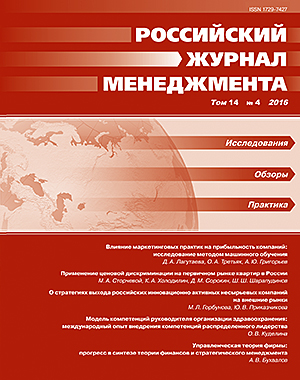Управленческая теория фирмы: прогресс в синтезе теории финансов и стратегического менеджмента
DOI:
https://doi.org/10.21638/11701/spbu18.2016.405Аннотация
Современный стратегический менеджмент объясняет конкурентное положение компании усилиями ее менеджеров по нахождению и построению специфических ресурсов и способностей. Корпоративные финансы говорят, что инвестор строит диверсифицированный портфель, учитывая только систематический риск (связь с управлением не прослеживается), тогда как специфический риск компании, связанный с управлением, не играет роли. Возникает парадокс: ценность фирмы не зависит от усилий менеджеров по управлению фирмой. По существу, все определяет отрасль (бета отрасли — рекомендуемый прокси-показатель для систематического риска компании). Настоящий обзор посвящен анализу недавнего прогресса в разрешении данного парадокса. «Пробой» заключается в рассмотрении шоков в идиосинкразических денежных потоках фирмы, что приводит к новой модели систематического риска, которая уже учитывает действия менеджеров. Указанные шоки связаны с исполнением реальных опционов роста — основного средства приспособления к неопределенности внешней среды, предлагаемого стратегическим менеджментом.
Ключевые слова:
систематический риск, специфический риск, CAPM, идиосинкразические денежные потоки, реальные опционы, стратегический менеджмент, управленческая теория фирмы
Скачивания
Библиографические ссылки
Translation of references in Russian into English
Загрузки
Опубликован
Как цитировать
Выпуск
Раздел
Лицензия
Статьи журнала «Российский журнал менеджмента» находятся в открытом доступе и распространяются в соответствии с условиями Лицензионного Договора с Санкт-Петербургским государственным университетом, который бесплатно предоставляет авторам неограниченное распространение и самостоятельное архивирование.





